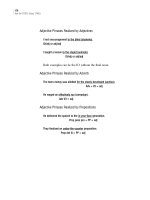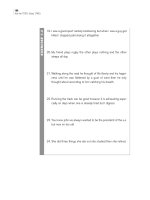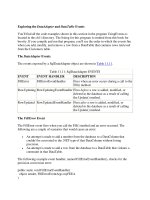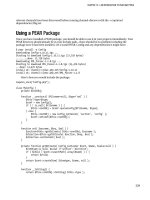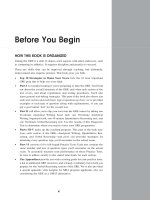Tài liệu Maximizing the Testing and Debugging Process pptx
Bạn đang xem bản rút gọn của tài liệu. Xem và tải ngay bản đầy đủ của tài liệu tại đây (32.67 KB, 2 trang )
< Day Day Up >
Maximizing the Testing and Debugging Process
There's no denying that testing and debugging is part of every programmer's life, but that
doesn't mean that it has to be an awful and overwhelming experience. Before we discuss
some of the tools that Flash provides to test and debug a project, here are some general
guidelines to follow as you build your project:
•
Plan. Don't approach a project until you've created a basic outline of how it should
work. You can't reach your end goal if you don't know your final destination.
•
Test everything. Never assume that something works—even if it seems a trivial
part of your project. All it takes is one mistake to bring your movie to a screeching
halt.
•
Test often. Don't wait until your project is nearing completion—test at every
opportunity. It's much easier to isolate problems if you know your movie was
working five minutes ago.
•
Fix bugs in an orderly fashion. Don't attempt to fix a bunch of bugs at the same
time. It's best to fix one or two problems at a time and then test after each. After
all, you don't want to create any new bugs in the process.
•
Avoid quick fixes. Maybe you're aware that a bug exists, but you're not sure why.
In an effort to save time, you may decide to attempt a quick fix or workaround,
rather than tracking down the problem. This kind of coding always costs more
time in the long run. Take the necessary time to track down the culprit.
•
Comment your code. It's a fact of life: many beginning coders just don't like using
comments in their code. They feel that it slows them down, and wastes time. Well,
it may seem like a waste of time to comment a project when you first begin coding
it. After all, you can typically figure out what your code is doing by simply
glancing at it. Start adding several hundred or even several thousand lines of code,
however, and your attitude will quickly change. Comments provide the means for
you to detail in human terms what a particular piece of code is doing. This can be
a great help as the number of lines of code in your project increases. A useful
technique is to comment before you start writing any code. This forces you to
think about the problem (breaking it down into commented steps) before diving
into it.
•
Know when to step away. Few things are as frustrating as knowing that something
should work, but yet it doesn't. In an attempt to resolve these problems, it's easy to
lose track of time, forget to eat, or even forget that you have friends and family.
Instead of doing all this forgetting, step away for awhile, refresh yourself, and
return to the bug-squashing process a little later. Sometimes, all it takes to locate a
nagging problem is to recharge your batteries.
Okay, so you've approached your project with a well-defined plan, used comments and a
standard naming convention, and double-checked all your code—but you still have a
project that's just not working properly. What can you do? The remainder of this lesson
will deal with that question.
< Day Day Up >



